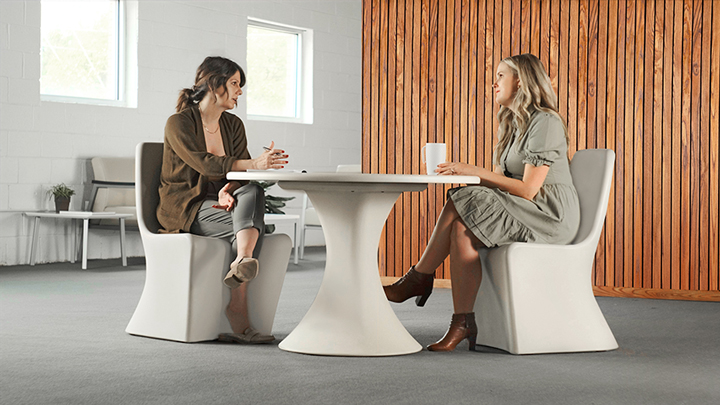
At Stance Healthcare, we make Behavioral Health furniture products that are designed not only to be durable and long-lasting, but also supportive of caring environments that nurture patients back to mental wellness and stability. This commitment to quality has never been more timely than in today’s post-COVID era, given the rise in demand for Mental and Behavioral Health services. In addition to the uptick in need, we’ve also experienced monumental changes to the way care is being delivered – including through telehealth spaces when in-person consultations present risks or are otherwise difficult to access.
With more and more patients taking advantage of virtual therapy sessions, how can Stance continue to support these new types of care environments? Suzanne Fawley, our Behavioral Health Interior Designer, offers the following tips to create comfortable, calming environments for telehealth appointments:
- Go multi-dimensional: “Zoom culture” has mainstreamed meetings that literally put us head-to-head with the other person in the virtual room. This dynamic can be especially intimidating for a patient who is experiencing a crisis or is simply nervous about beginning therapy. An immediate way to alleviate this concern and instead create a welcoming setting for patients is to open up the camera view to show the full room. Ideally, this will reveal a comfortable-looking seating area that includes a chair, such as Stance’s Verity seating, in which patients may imagine themselves relaxing during the session. By taking in more than just a face in their view, patients might more easily envision themselves in an actual therapy session, rather than being unnerved by the up-close shot of a care provider.
- Project humanity and relatability: As we think about other ways to expand outside of this one-dimensional setting, care providers and healthcare designers should consider displaying familiar objects in the space to put patients at ease and instill their confidence in the process they’ve just virtually stepped into. Some ideas for this include displaying aesthetically soothing or recognizable works of art, including paintings; arrangements of flowers and other living plants; or academic or industry insignia.
- Conjure a sense of calm: We always focus on supporting healthcare spaces like hospitals and therapeutic areas with color, texture, and products that encourage patients, providers, and visitors to relax and feel at ease. In our virtual settings, we should strive to replicate this impact. One example of how to support such a space is selecting soothing tones, such as earth-inspired or spa-like hues, for the walls and furnishings – similar to many of the color palettes we use on Stance’s Behavioral Health website. Another is choosing soft lighting and conducting trial appointments to test the lighting’s display on different devices. Halo lighting is also recommended to bring life to the care provider’s face and remove any shadows.
- Ditch “the desk” and invite the patient to sit in comfort: In the first point, we mentioned showing patient seating in view during a telehealth appointment. Doing this allows patients to envision themselves in the room – and while we’re thinking about that, let’s reframe the way we depict the provider’s seating area, too. Typically, a therapist will sit behind a desk in Behavioral Health settings, but the current trend is leaning toward a more conversational seating arrangement. This may include a settee and lounge chair scenario or multi-use table seating, thanks to more comfortable, yet safe seating options like Stance’s Flo Dining Collection. Approachable seating options to engage at the same level with patients in a supervised in-person or telehealth setting is the goal. We can mimic this virtually by replacing the view of a physician behind a desk with that of a care provider sitting in a relaxed position that invites conversation.

“I find it interesting that, following an era of forced separation in the height of COVID, we are now living in an era dominated by virtual meetings,” says Suzanne. “Adding to the sense of separateness are the virtual backgrounds and the fuzzy filters many people use. And for telehealth appointments especially, this may convey an artificial persona and inhibit connection. But with just a few changes, we have an opportunity in healthcare to rebuild that interpersonal connection by ‘warming up’ our approach to telehealth spaces. When we support a more inviting virtual space, patients can log in and envision themselves taking a seat and becoming comfortable – more like they were there in person.”
By using these tips and working with an experienced healthcare design team, providers can achieve a supportive, trusted space for consultative therapy. We appreciate Suzanne sharing these insights with us. Want to hear more from Suzanne? You can catch her on this topic and more during her upcoming appearance at this year’s Healthcare Design Expo + Conference in San Antonio. Check out her session information here – and make sure to find the Stance team at our booth and say hello as well!